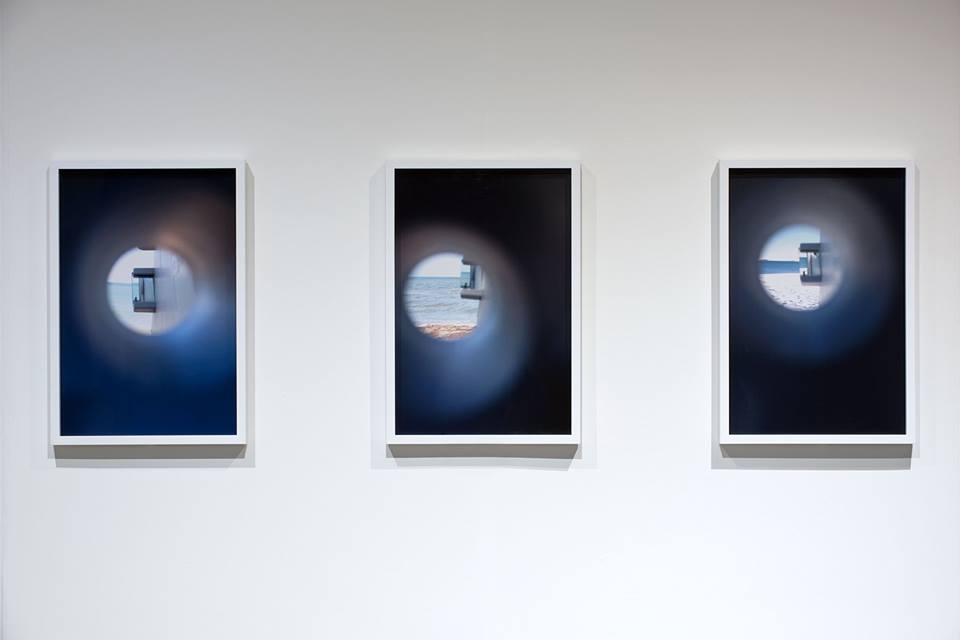TERROIR Q&A SERIES: CARLY BUTLER

Terroir: a Nova Scotia survey is on view until January 15, 2017. The accompanying exhibition publication is now available for pre-sale at the Gallery Shop.
What is your connection to Nova Scotia, and why were you inspired to submit a work for this exhibition?
I moved to Nova Scotia in 2010 to finish my degree at NSCAD and then stayed in Halifax until this past summer (2016) when I had to return to British Columbia. The opportunity to be part of a survey of Nova Scotian artists is a great honour and I continue to be influenced by the culture, history, and landscape of the province.

Can you tell us a little about your works that are on view?
I have two projects on view: Index Error and Anywhere Else. The Index Error series of photographs are shot through a sextant and reveal the error inherent when the direct horizon and reflected horizon do not line up. As a picture of an inaccurate reading of location, the work speaks of failed navigation and our inability to locate ourselves.
Anywhere Else is an ongoing video series using an inflatable life raft as a manifestation of restlessness and longing. The work explores ideas of redemption and regret, with the raft itself a symbol of both survival and disaster. Pulling the raft is at once heroic, yet futile and seemingly endless; there is no final destination.
Your works are on view along with 28 other artists. How do you see your work within the context of this group exhibition?
Unfortunately I moved across the country just before the opening so was unable to see my work in the context of the exhibition. From the artists whose work I am familiar with, I’m impressed with the diversity of practices represented and how we respond to the idea of place in such different and interesting ways.
What are you working on in now, or planning for the near future?
I was recently part of a group exhibition in Toronto at Georgia Scherman Projects that is travelling to ArtYard in Frenchtown, New Jersey. I had a 4ft anchor cast in resin for that show and am now working on casting a series of 126 anchors in plaster – one for each shipwreck on the west coast of Vancouver Island. The West Coast Trail was built to rescue shipwrecked sailors and is near where I grew up and have now returned to live. Really I’ve simply traded one coast for another, which is helpful in terms of continuing to work with nautical themes! Living in both areas has really highlighted the differences of each coast, and I’ve been inspired to delve deeper into the history of seafaring on both sides of the country.


How has your artistic process developed over time? What informs your practice?
My practice usually reflects on our relationship to the sea, using the subjects of navigation and survival to reflect a range of issues that develop at particular points in time dependent on what’s happening in my life and where I’m living/travelling/working.
Often inspired by the writings of philosophical French solo sailor Bernard Moitessier, and Nova Scotian sailor Joshua Slocum, I also reference nautical instructions and manuals from a number of sources such as, Weather for the Mariner and various volumes of the British Admiralty Manual of Navigation from 1965 and on. Moitessier was most famous for abandoning his chance to win the first solo non-stop circumnavigation – sending a message by slingshot to a passing freighter explaining that he was continuing around again ‘to save my soul.’ Slocum was the first person to ever sail around the world alone, and saw navigating using a chronometer (clock) as unnecessary ‘technology’, preferring traditional methods using the stars. If the sea has something to teach us, then it was Moitessier and Slocum who epitomized its lessons.
Slocum and Moitessier’s writings about sailing serve as the catalyst for my current body of work as they bridge the technical with the philosophical, making us aware of layers of meaning to be found in the most seemingly banal instructions for surviving life alone on the ocean.

